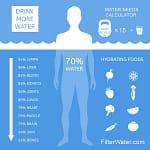Bottled Water in America: Sources, Manufacturers, and Potential Risks
Overview of Bottled Water in America
In America, bottled water has become a popular choice for many individuals seeking a convenient and portable source of hydration. However, it may come as a surprise to learn that a significant portion of bottled water in the country is sourced from tap water rather than the picturesque mountain springs often depicted on the labels. In this article, we will explore some of the leading bottled water manufacturers in America and discuss the potentially harmful contents of some of these products. We will also examine bottled water regulations to provide a comprehensive understanding of the industry.
A few names immediately come to mind when it comes to the leading bottled water manufacturers in America. Nestlé Waters, the parent company of popular brands like Poland Spring, Deer Park, and Arrowhead, holds a significant market share. The Coca-Cola Company, through its brand Dasani, is also an essential player in the bottled water market. Other notable manufacturers include PepsiCo (Aquafina), Danone (Evian), and Fiji Water.
While bottled water is often perceived as a healthier alternative to sugary drinks, there have been concerns about the potentially harmful contents found in some products.
For instance, studies have shown that certain plastic bottles used for packaging water may contain toxic chemicals such as bisphenol A (BPA) and phthalates, which can leach into the water and pose health risks when consumed over time. Additionally, the quality of water sourced from tap water and then bottled can vary, with some studies finding contaminants like bacteria, heavy metals, and even pharmaceuticals in specific brands.
The United States Food and Drug Administration (FDA) regulates bottled water as a packaged food product to address these concerns. The FDA sets specific standards for labeling, production, and quality control to ensure bottled water is safe for consumption. However, it is essential to note that the FDA’s regulations do not require bottled water to be safer than tap water. In fact, in many cases, tap water is subject to more rigorous testing and safety standards than bottled water.
In conclusion, the bottled water industry in America is a multi-billion dollar business, with various manufacturers competing for consumer attention. While bottled water offers convenience and portability, it is essential to be aware of the potentially harmful contents found in some products. Understanding bottled water regulations can help consumers make informed choices about their hydration options. In the following sections, we will delve deeper into the manufacturing processes, environmental impact, and alternatives to bottled water, providing a comprehensive overview of this ubiquitous industry.
Leading Manufacturers of Bottled Water in America
There are several prominent manufacturers in the bottled water industry in America. While this is not an exhaustive list, here are a few well-known companies:
- The Coca-Cola Company: Coca-Cola produces various bottled water brands, including Dasani and SmartWater. Dasani, for example, is sourced from local municipal water supplies and undergoes a purification process before being bottled and distributed to consumers. SmartWater, on the other hand, is vapor-distilled and then enhanced with electrolytes for taste.
- PepsiCo: PepsiCo is the parent company of Aquafina, one of the leading bottled water brands in the United States. Aquafina sources its water from public water sources and uses a filtration process called reverse osmosis to remove impurities.
- Nestlé Waters: Nestlé Waters owns multiple brands, such as Poland Spring, Deer Park, and Arrowhead. Poland Spring, for instance, is sourced from natural springs in Maine and undergoes a rigorous filtration process to ensure its purity.
- Dr. Pepper Snapple Group: Dr. Pepper Snapple Group’s subsidiary, Snapple, offers bottled water under Snapple Natural Spring Water. This brand sources water from natural springs and is carefully protected to maintain quality and taste.
- Private Label Brands: Many supermarkets and retail chains also offer private-label bottled water products. These brands often source their water from reputable suppliers and provide affordable options for consumers.
It is important to note that not all bottled water brands source their water from tap water. Some companies obtain their water from natural springs or other pristine sources. However, consumers must read the labels and research to understand the true origin of the water they purchase. By doing so, consumers can make informed choices and select bottled water that aligns with their preferences and values.
Potential Harmful Contents in Bottled Water
While the majority of bottled water is safe for consumption, there have been instances where certain products have been found to contain potentially harmful substances. Here are a few examples:
- Microplastics: Studies have discovered the presence of microplastics in some bottled water, which are tiny plastic particles that can enter the water during the manufacturing and packaging processes. Although the health effects of consuming microplastics are not yet fully understood, they are concerning. Research suggests that these particles may have the potential to accumulate in the human body over time, leading to possible long-term health consequences. Furthermore, microplastics have been found to act as carriers for other pollutants, such as heavy metals and chemicals, which can further exacerbate the health risks associated with their consumption.
- Chemical Contaminants: Bottled water can sometimes contain chemical contaminants, such as phthalates and bisphenol A (BPA), which may leach into the water from the plastic bottles. These chemicals have been associated with various health risks, including hormone disruption. Phthalates, for example, are commonly used in the production of plastic bottles and have been linked to reproductive and developmental issues. On the other hand, BPA is used in the lining of some plastic bottles and has been shown to mimic estrogen in the body, potentially leading to hormonal imbalances. While regulations are in place to limit the presence of these chemicals in bottled water, consumers need to be aware of the potential risks and choose products labeled as BPA-free and phthalate-free.
- Disinfection Byproducts: Some bottled water products may contain disinfection byproducts, such as trihalomethanes, formed when disinfectants react with organic matter in the water. Prolonged exposure to high levels of these byproducts may increase the risk of specific health issues. Trihalomethanes have been associated with an increased risk of cancer, as well as reproductive and developmental problems. While the levels of these byproducts in bottled water are generally within regulatory limits, individuals who consume large quantities of bottled water as their primary source of hydration may be at a higher risk of exposure. Consumers must be aware of the potential presence of disinfection byproducts and consider alternative drinking water sources, such as filtered tap water if they have concerns.
It is important to note that not all bottled water products contain these harmful substances. However, consumers should know the potential risks and choose their bottled water brands wisely. Reading the product labels and conducting research can help individuals make informed decisions about the water they consume. Additionally, individuals can reduce their reliance on bottled water by investing in reusable water bottles and utilizing water filtration systems at home. By taking these steps, consumers can minimize their exposure to potentially harmful substances and contribute to a more sustainable approach to water consumption.
Regulations Surrounding Bottled Water
The bottled water industry in America is regulated by the U.S. Food and Drug Administration (FDA) and the Environmental Protection Agency (EPA). The FDA has established specific standards for bottled water labeling, quality, and manufacturing processes. On the other hand, the EPA is responsible for regulating the quality of tap water supplied by public water systems.
Under FDA regulations, bottled water must meet the same strict standards as tap water. This includes adhering to the maximum contaminant levels the EPA sets for various substances. However, it is essential to note that the frequency of testing and reporting requirements differ between bottled and tap water. Public water systems must regularly test and report their water quality results, while bottled water companies are not subject to the same level of transparency.
Consumers can find valuable information about tap water quality by reviewing the Consumer Confidence Reports (CCR) provided by their local water utility. These reports detail the water source, any detected contaminants, and compliance with regulatory standards. On the other hand, bottled water companies are not required to disclose the same level of information to consumers.
While the regulations aim to ensure the safety of bottled water, consumers need to be proactive in understanding the potential risks and benefits associated with different brands. Reading labels, researching the manufacturer’s practices, and staying informed about recalls or safety concerns can help individuals make informed choices when purchasing bottled water.
In recent years, there has been growing concern about the environmental impact of single-use plastic bottles in the bottled water industry. These bottles contribute to plastic waste and pollution, as many end up in landfills or oceans. As a result, some consumers have started to question the sustainability of bottled water and have turned to alternative options.
One alternative to traditional bottled water is reusable water bottles. These bottles are made from materials such as stainless steel or glass, which are more durable and can be used multiple times. Many reusable water bottles also come with built-in filters, allowing individuals to fill them with tap water and remove any impurities.
Another option gaining popularity is home water filtration systems. These systems can be installed directly into a home’s plumbing, providing filtered water on demand. They remove contaminants such as chlorine, lead, and bacteria, ensuring the water is safe to drink. Home filtration systems offer a long-term solution for individuals who want to reduce their reliance on bottled water.
Additionally, some communities have implemented water refill stations, where individuals can refill their reusable water bottles for free or at a minimal cost. These stations are often found in public places such as parks, schools, and airports, making it convenient for people to access clean drinking water while on the go.
As consumers become more aware of the environmental impact of bottled water, they are seeking out alternative options to reduce waste and make more sustainable choices. While regulations play a crucial role in ensuring bottled water’s safety, individuals are also responsible for considering the broader implications of their consumption habits and making choices that align with their values.














